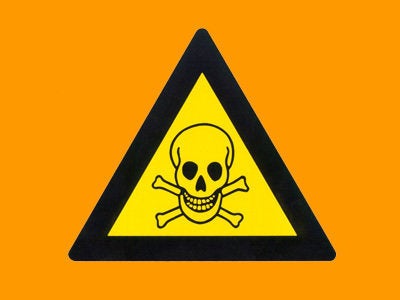
Recently I read that brominated fire retardants -- ubiquitous in whatever electronic device you're using right now -- are carcinogenic. Now brominates are helpful: they keep our stuff from bursting into flames, which is why they're peppered in our carpets, paint and upholstery, as well as computer circuits and cabinets. But a few days later I read another little news item saying that those objects shed and off-gas brominates molecules, which end up in house dust -- and so in you and me.
Such cheery bits of science news come to me daily in a free email feed from Above the Fold, a project of the Environmental Health Working Group. These folks, a network of experts in medical and environmental science, are tracking all the ways molecules that should never have been put into play in the first place, but which permeate our manufactured goods, wreak havoc in nature and in our bodies.
There are, it seems, about 100,000 industrial chemicals in regular use in manufacturing and the things we buy -- 62,000 of which were arbitrarily grandfathered in as "safe" by virtue of their being used already, way back in the 1970s, when the Environmental Protection Agency was first created. Those chemicals included some like ethyl benzene, an industrial solvent that medical studies show to be a powerful neurotoxin. But the most disturbing problem, according to a report by the Government Accounting Office, is that 30 years later the EPA has required testing of only a few hundred or so of those chemicals. The rest -- including the many thousands of compounds introduced since -- are mysteries.
Since then, toxicologists have evaluated the safety of industrial chemical in a model that assumes one chemical causes a given disease or biological defect. That model makes it hard to find conclusive evidence that a chemical that causes, say, breast cancer in lab rates, will be dangerous in humans. Yet there's no doubt such a compound is a "chemical of concern," something best to avoid -- even though manufacturers can claim that, technically, it "poses no health risk."
Some toxicologists argue their discipline may have a blindspot when it comes to the stew of chemicals we breathe, drink, or otherwise absorb over the course of life. Studies are showing, for instance, that simultaneous exposure to two different chemicals, each of which passes the standard test for toxicity, can cause damage like the neural degeneration seen in Parkinson's Disease. In short, we need new thinking on "toxic": it's not just one chemical -- it's the whole mix. That mix, other studies show, causes inflammation and oxidative stress, which set the stage for diseases from asthma and diabetes to cancer.
Another problem: our bodies accumulate these chemicals. When I talked about this dilemma with Michael Lerner, head of Commonweal in Bolinas, California, I learned that when and his wife Cheryl Patton had been tested for their "body burden" of suspect chemicals, they discovered they carry a multitude of toxic compounds. But so do we all -- extensive body burden tests have failed to find anyone anywhere free of industrial toxins.
Consider the home experiments done by Rick Smith, author of one of the best-named books of all time: Slow Death by Rubber Duckie: How the Toxic Chemistry of Everyday Life Affects out Health. In a heroic move akin to "Supersize Me," Smith purposely exposed himself to suspect chemicals in everyday products and had his body assayed to see the effects. When he spent two days restricting his diet to canned foods heated in polycarbonate plastic storage containers, the levels of bisphenol-A -- the hormone-disrupter linked to breast and prostate cancer -- jumped 7.5 times.
The best defense against this chemical stew is to lessen our exposure. This "precautionary principle" already guides policy in the European Union, where an ambitious project is underway to test for toxicity all those tens of thousands of industrial chemicals that were grandfathered years ago. The plan: publish lists of chemicals that show troubling results as a heads-up for manufacturers to start searching for alternatives that are safe.
In the States we can send the same message to companies without waiting for the government to act. How? By voting with our dollars for safer chemicals every time we shop.
SkinDeep.com, another project of the Environmental Working Group, evaluates every chemical in those long ingredient lists on the back of shampoos, baby wash, lip gloss -- every personal care product. SkinDeep.com does the homework for us, searching in medical databases to see if there are any findings that would make a given ingredient a "chemical of concern" -- such as lowering sperm counts or causing nerve disorders.
The website GoodGuide.com expands the search beyond personal care products to include food, household cleaners, and toys (with more products being added). GoodGuide.com comes also as a free app for the iPhone, and some retailers are considering putting it's 10-point ratings next to the price tags of products so we don't need to go to the Web to get the truth.
Daniel Goleman blogs at www.danielgoleman.info. His audio investigations of ecological intelligence can be heard at http://www.morethansound.net/ecological-awareness.php.